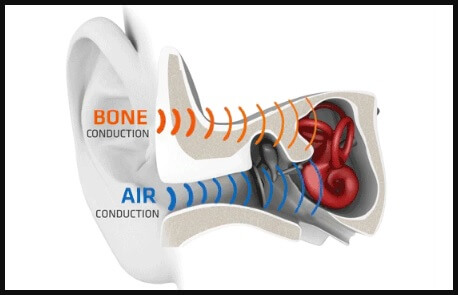Bone conduction hearing technology is a revolutionary way for individuals with or without hearing loss to experience sound.
Unlike traditional hearing aids that amplify sound waves and send them into the ear canal, bone conduction hearing devices use vibrations to transmit sound through the skull and directly to the inner ear.

How Bone Conduction Hearing Technology Works
The inner ear, also known as the cochlea, is responsible for converting sound waves into electrical signals that are sent to the brain.
In individuals with hearing loss, the cochlea may not be able to properly process these sound waves.
Bone conduction hearing technology bypasses this issue by vibrating the skull and allowing the cochlea to receive the vibrations directly.
There are two main types of bone-conduction hearing devices:
Bone Anchored Hearing Aids (BAHA): These devices are surgically implanted and use a small magnet to connect to an external sound processor. The sound processor sends vibrations through the skull and directly to the inner ear.
Bone Conduction Headphones: These devices sit on the outside of the ear and use a transducer to send vibrations through the skull and directly to the inner ear.
Benefits of Bone Conduction Hearing Technology
%5D(https://mermaid.live/edit#pako:eNo9j70OgzAMhF_F8lxegKESP0O7VaIbYbAStyAlMQrJgBDv3lCq3nS6-yydN9RiGEt8B5pHeLbKQ1bVN6JHyzRAUVyh7uvqVkEBXQrvSZO1K9zdbMlHNsN5Un_Jpu8keQOPIJqXRcKvbY62On3b1-IZGvEm6TiJhxuTmcccLsOfwws6Do4mk9dtR6IwjuxYYZmt4RclGxUqv2eUUpRu9RrLGBJfMM2GIrcT5b8cli-yC-8fIxZLug))
Benefits of Bone Conduction Hearing Technology
Bypasses outer and middle ear issues: Traditional hearing aids can only amplify sound waves if the outer and middle ear is functioning properly.
With bone conduction hearing technology, the sound is delivered directly to the inner ear, bypassing any issues in the outer and middle ears.
Allows for a more natural hearing experience: Traditional hearing aids can sometimes amplify background noise and make it difficult to distinguish between different sounds.
Bone conduction hearing technology allows for a more natural hearing experience as the sound is delivered directly to the inner ear.
Can be used by individuals with conductive hearing loss: Conductive hearing loss is caused by issues in the outer or middle ear, such as a blockage or a malformation.
Traditional hearing aids may not be effective for these individuals, but bone conduction hearing technology can bypass these issues and provide a hearing solution.
Potential Risks and Side Effects
Surgical implantation: BAHA devices require surgical implantation and there is a risk of complications associated with any surgery.
Skin irritation: The external sound processor for BAHA devices can cause skin irritation if not properly cleaned and maintained.
Vibration sensation: Some individuals may feel a vibration sensation when using bone-conduction hearing devices.
In Summary
Bone conduction hearing technology is a revolutionary way for individuals with hearing loss to experience sound.
By bypassing outer and middle ear issues and allowing for a more natural hearing experience, bone conduction hearing devices can provide a hearing solution for those who may not be able to use traditional hearing aids.










130 comments
pwsgmbyvzk
Muchas gracias. ?Como puedo iniciar sesion?
ydrtoosyer
Muchas gracias. ?Como puedo iniciar sesion?
nipamecdcp
Muchas gracias. ?Como puedo iniciar sesion?
tnlsydvxvn
Muchas gracias. ?Como puedo iniciar sesion?
wydtkkyuqf
Muchas gracias. ?Como puedo iniciar sesion?
vmrslnyrwn
Muchas gracias. ?Como puedo iniciar sesion?
umrtfctbfx
Muchas gracias. ?Como puedo iniciar sesion?
hjerfdzkgd
Muchas gracias. ?Como puedo iniciar sesion?
upjzcoqrqa
Muchas gracias. ?Como puedo iniciar sesion?
qlryhwxcxv
Muchas gracias. ?Como puedo iniciar sesion?
kpexjbsgqi
Muchas gracias. ?Como puedo iniciar sesion?
selprghskw
Muchas gracias. ?Como puedo iniciar sesion?
yluydxcmcc
Muchas gracias. ?Como puedo iniciar sesion?
acpsrgsiaw
Muchas gracias. ?Como puedo iniciar sesion?
pfqgojjekq
Muchas gracias. ?Como puedo iniciar sesion?
Leave a comment
This site is protected by hCaptcha and the hCaptcha Privacy Policy and Terms of Service apply.